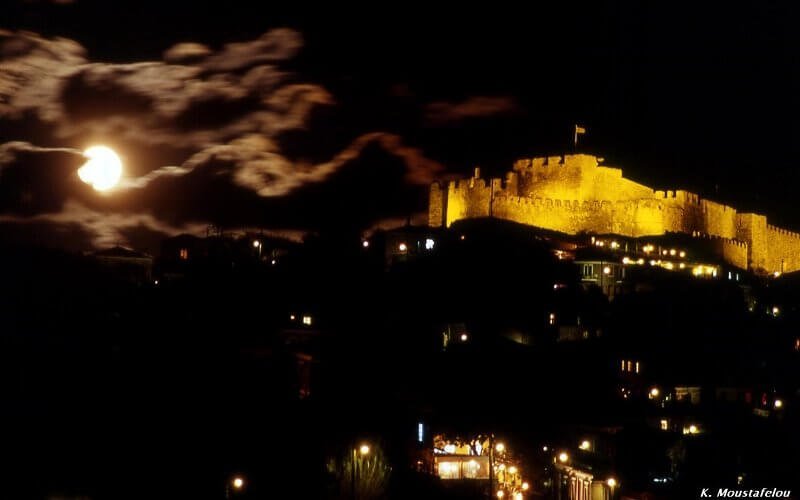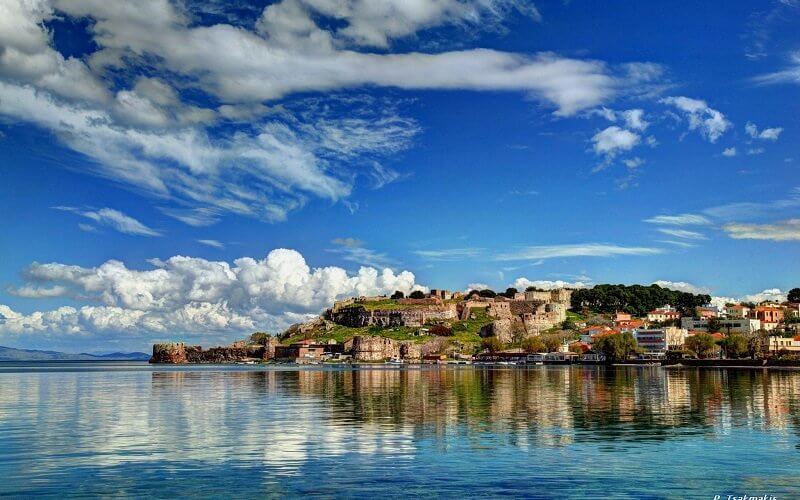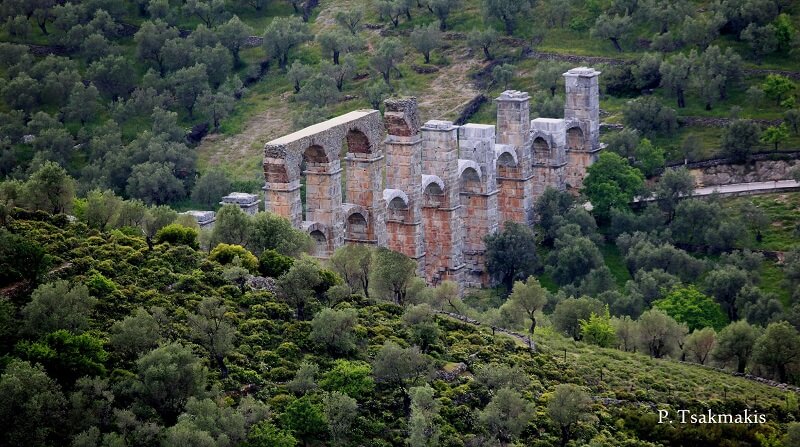 The castle of Mytilini, one of the biggest in Mediterranean, is located at the northeast part of the city on a pine-covered hill. During antiquity, the peninsula on which the castle was built, was an islet, close to Lesvos. Its construction phases were completed in three time periods: The Byzantine period, the Gattilusi period and the Ottoman period.
The castle of Mytilini, one of the biggest in Mediterranean, is located at the northeast part of the city on a pine-covered hill. During antiquity, the peninsula on which the castle was built, was an islet, close to Lesvos. Its construction phases were completed in three time periods: The Byzantine period, the Gattilusi period and the Ottoman period.
It is probably constructed during the reign of Justinian on the remnants of a previous fortification with the use of older building material. From the first period, the eastern wall of the Keep (Akropyrgos), a Byzantine small gate at the northeast walls and the cistern in the middle castle are still preserved. Important additions took place (1373-1462) during the Gattilusi period. In 1373, a complex of towers (polypyrgo), with bastions and moats were built by Francesco I. During that period the castle’s area was separated in two parts, the Upper and the Middle Castle. A significant part of it was destroyed by the earthquake of 1384, which was however restored at the beginning of 15th century and then it was fortified with defensive works. The palace of Gattilusi, a square stone tower with a walled in inscription with the Gattilusi coats-of-arms and representations of Roman duels as well as a plaque of the Palaiologi coats-of-arms at the exterior gate are saved until today. In 1462 the island was occupied by the Turks. New interventions at the castle were made during the Ottoman period, when its lower north part was built (Lower Castle). Some of the buildings still preserved are the gunpowder warehouse, the military hospital-prisons, the Medrese (Muslim religious school), the Tekes (Ottoman monastery) and the ruins of Koule Mosque. After the liberation from the Turks in 1912, the castle was used as a military camp. Since the ’70s, the castle restored and conserved serves as a monument. Today, it is used as a cultural event site during summer.
Tel.: +30 22510 27790
Admission: Full: €2, Reduced: €1
Opening Hours: 08:00-15:00
Sources: http://odysseus.culture.gr/h/3/gh352.jsp?obj_id=15684
http://www.mytilene-castle.gr/
 The castle of Molyvos (Castle of Mithymna) is the region’s landmark, since it stands imposingly on the hill above the settlement. Its location was of strategic importance, allowing the control of the northern passage to the gulf of Adramyttium. It was erected during the Byzantine period on the remains of an ancient acropolis at the region of Mithymna and possibly was completed in 1373 by the Genoese Francesco I Gattilusο. During Ottoman period many additions to its defenses were made which remain until today. In its present form, an inner wall separates it in two. The access to the castle is made by three consecutive gates. The external one opens to the southern end of the outer ward and dates back to the Ottoman period. At a shorter distance, the second gate leads to an open-air yard which is protected by the walls. The third gate is the castle’s main entrance, is found at the end of a cobbled street, and dates back to 14th c. The entrance’s wooden door with metal coating (Ottoman period) presents a great interest. At the castle’s interior, the remaining buildings date back to Ottoman period. One of them was possibly used as a gunpowder warehouse. It is considered one of the best preserved castles in the east Mediterranean and during summer cultural events take place at its premises.
The castle of Molyvos (Castle of Mithymna) is the region’s landmark, since it stands imposingly on the hill above the settlement. Its location was of strategic importance, allowing the control of the northern passage to the gulf of Adramyttium. It was erected during the Byzantine period on the remains of an ancient acropolis at the region of Mithymna and possibly was completed in 1373 by the Genoese Francesco I Gattilusο. During Ottoman period many additions to its defenses were made which remain until today. In its present form, an inner wall separates it in two. The access to the castle is made by three consecutive gates. The external one opens to the southern end of the outer ward and dates back to the Ottoman period. At a shorter distance, the second gate leads to an open-air yard which is protected by the walls. The third gate is the castle’s main entrance, is found at the end of a cobbled street, and dates back to 14th c. The entrance’s wooden door with metal coating (Ottoman period) presents a great interest. At the castle’s interior, the remaining buildings date back to Ottoman period. One of them was possibly used as a gunpowder warehouse. It is considered one of the best preserved castles in the east Mediterranean and during summer cultural events take place at its premises.
Tel.: +30 22530 71803
Admission: Full: €2, Reduced: €1
Opening Hours: 08:00 -15:00
Source: http://odysseus.culture.gr/h/3/gh352.jsp?obj_id=15685
 The castle of Sigri is located at the western end of Lesvos. It is a small castle, typical sample of Ottoman style, built during the Turkish occupation. It is well-preserved in its original form. It was built in the mid-18th century by the admiral of the Ottoman fleet Suleiman Pasha, to protect the region’s commercial harbor from piracy. The castle extends at a square ground plan with square fortification towers and its main characteristic is the Arabic arch with red and white stones over its gate. At least until the end of 19th c., the region’s settlement was developed around the castle. During the 19th c. and until 1912 military units were settled in the castle. According to testimonies, it was well preserved and equipped to prevent possible local riots, however it could not stand a coordinated attack by the sea. Parts of the castle’s walls collapsed due to the 1889 earthquake in the western Lesvos. In the summer of 1915, during the World War I, it operated as Entente’s base and supply station.
The castle of Sigri is located at the western end of Lesvos. It is a small castle, typical sample of Ottoman style, built during the Turkish occupation. It is well-preserved in its original form. It was built in the mid-18th century by the admiral of the Ottoman fleet Suleiman Pasha, to protect the region’s commercial harbor from piracy. The castle extends at a square ground plan with square fortification towers and its main characteristic is the Arabic arch with red and white stones over its gate. At least until the end of 19th c., the region’s settlement was developed around the castle. During the 19th c. and until 1912 military units were settled in the castle. According to testimonies, it was well preserved and equipped to prevent possible local riots, however it could not stand a coordinated attack by the sea. Parts of the castle’s walls collapsed due to the 1889 earthquake in the western Lesvos. In the summer of 1915, during the World War I, it operated as Entente’s base and supply station.
Tel.: +30 30 22510 40135
Admission: Full: €2, Reduced: €1
Opening Hours: 08:00 -15:00
Source: http://odysseus.culture.gr/h/2/gh251.jsp?obj_id=7781
 The archaeological site of Thermi is found at the east coast of the island about 10 km north of Mytilini. It was identified and excavated by the British School of Athens and the archaeologist Winifred Lamb, during 1929-1933. The research revealed a significant city of the Early Bronze Age (3200-2400 BC.) with five consecutive building phases (Thermi Ι-V), as well as settlement remains of the Middle and Late Bronze Age (2000-1300 BC.). After the completion of the excavations, the site was backfilled to protect the remains and remained inaccessible for many decades. In 2005 its refurbishment and presentation started, which was completed in December 2008. The new research works brought to light spacious houses of the Middle and Late Bronze Age, potters’ kilns and infant burials, as well as clay vessels, clay statuettes, metal, stone and bone tools etc. The excavated area covers about 0,8 ha, but it is assumed that almost as much as this was lost by sea erosion. In the premises of the site which is open to public, you can also see the mock-up models of the prehistoric settlement and receive information material.
The archaeological site of Thermi is found at the east coast of the island about 10 km north of Mytilini. It was identified and excavated by the British School of Athens and the archaeologist Winifred Lamb, during 1929-1933. The research revealed a significant city of the Early Bronze Age (3200-2400 BC.) with five consecutive building phases (Thermi Ι-V), as well as settlement remains of the Middle and Late Bronze Age (2000-1300 BC.). After the completion of the excavations, the site was backfilled to protect the remains and remained inaccessible for many decades. In 2005 its refurbishment and presentation started, which was completed in December 2008. The new research works brought to light spacious houses of the Middle and Late Bronze Age, potters’ kilns and infant burials, as well as clay vessels, clay statuettes, metal, stone and bone tools etc. The excavated area covers about 0,8 ha, but it is assumed that almost as much as this was lost by sea erosion. In the premises of the site which is open to public, you can also see the mock-up models of the prehistoric settlement and receive information material.
Tel.: +30 22510 71705
Admission: Full: €2, Reduced: €1
Opening Hours: Tuesday to Sunday: 08:00-15:00
The Ancient Theatre is found at the north part of Mytilini at a pine-covered area and its construction is connected to the expansion of the ancient city. It is one of the biggest theatres in Greece. The first architectural phase of the theatre is dated to the early Hellenistic period. The last architectural phase of the theatre, dated to the Roman period, is the one seen today. The horseshoe-shaped cavea of a diameter of 107m would have a capacity of about 10.000 people. The circular orchestra has a diameter of ca. 24m. and is separated from the cavea, now completely ruined, by a wall with marble orthostates. The skene is divided by three corridors; in the middle corridor a built drainage channel was uncovered. Two rooms, quarried out in the rock of the cavea, were found to the west of the orchestra. Fragments of architectural members prove there were also other buildings at the site.
Tel.: +30 22510 22741
Admission: free
Source: http://odysseus.culture.gr/h/2/eh251.jsp?obj_id=752
 The Roman aqueduct of Mytilene was probably constructed at the end of the 2nd or the beginning of the 3rd century A.D. Because of its typical classicistic elements, it was considered to have been built by Hadrian. It was used to transport water from the copious springs of mount Olympos to the ancient city of Mytilene, at a distance of ca.26 km. It supplied the city with large quantities of water and its carrying capacity has been estimated at 127.000 cubic meters a day. Part of the row of arches of the Roman aqueduct of Mytilene is visible at the site called Moria. The preserved section is 170 m. long and includes seventeen arches. Every opening is subdivided into three arches supported by a pillar and each pillar is crowned by a capital bearing a cymatium and abacus. The wall masonry is built in the “emplekton” system, with two parallel rows of stone filled with rubble. The pillars and the arcs of the arches are built of local marble. Smaller sections are saved at the sites Paspala and Kamaroudia.
The Roman aqueduct of Mytilene was probably constructed at the end of the 2nd or the beginning of the 3rd century A.D. Because of its typical classicistic elements, it was considered to have been built by Hadrian. It was used to transport water from the copious springs of mount Olympos to the ancient city of Mytilene, at a distance of ca.26 km. It supplied the city with large quantities of water and its carrying capacity has been estimated at 127.000 cubic meters a day. Part of the row of arches of the Roman aqueduct of Mytilene is visible at the site called Moria. The preserved section is 170 m. long and includes seventeen arches. Every opening is subdivided into three arches supported by a pillar and each pillar is crowned by a capital bearing a cymatium and abacus. The wall masonry is built in the “emplekton” system, with two parallel rows of stone filled with rubble. The pillars and the arcs of the arches are built of local marble. Smaller sections are saved at the sites Paspala and Kamaroudia.
Tel.: +30 22510 22087
Admission: free
Opening Hours: the site is always open to visitors
Source: http://odysseus.culture.gr/h/2/eh251.jsp?obj_id=1832
 Ancient Mithymna, was the second city-state of Lesvos in size and power. Its location coincides with the contemporary settlement of Molyvos (Mythimna). It was built on a peninsula; its acropolis was found where the Medieval Castle stands now and there was an effective fortification from the land side. At first, the city was extended just around the acropolis, but from the 5th c. BC, as a result of the economic and population growth, it expanded mainly to the northeast at the contemporary site of “Ntapia” with a consecutive expansion of the necropolis to the south, at the plain along the road from Mithymna to Antissa.
Ancient Mithymna, was the second city-state of Lesvos in size and power. Its location coincides with the contemporary settlement of Molyvos (Mythimna). It was built on a peninsula; its acropolis was found where the Medieval Castle stands now and there was an effective fortification from the land side. At first, the city was extended just around the acropolis, but from the 5th c. BC, as a result of the economic and population growth, it expanded mainly to the northeast at the contemporary site of “Ntapia” with a consecutive expansion of the necropolis to the south, at the plain along the road from Mithymna to Antissa.
However, the recent excavations prove that the greatest flourishing of the ancient city of Mithymna was seen during the archaic period, when it covered the greatest area which is identified almost as the contemporary traditional settlement. Since the 4th century BC, the city had been limited to the acropolis and “Ntapia”, where today a section of the defensive wall of the Hellenistic era is saved, incorporated to the Medieval Castle standing today. The archaic cemetery of the city and building remains of the Hellenistic city are found at the site of “Ntapia” while the necropolis of the Hellenistic and roman times was identified along the road from Mithymna to Petra. Finally, in the east of the modern harbor at Kepetzis street a bath complex of the Hellenistic times and the roman occupation (3rd c. BC. ? 3rd c. AD) was revealed, with rectangular spaces of cold and warm water, connected with corridors and a common water supply and drainage pipe system. Today, Mithymna is one of the most important protected traditional settlements of the Aegean.
Tel.: +30 2510 22087
Admission: free
Opening Hours: the site is always open to visitors
Source: http://odysseus.culture.gr/h/3/gh351.jsp?obj_id=2563
The Archaic sanctuary of Apollo at Klopedi is found at the homonymous rural region, north of the Gulf of Kalloni, near the settlement of Agia Paraskevi and it consists of two temple buildings of Aeolic order. The sanctuary at Klopedi, the oldest saved on Lesvos, is characterised as a milestone monument for its contribution to the history of architecture, as it is a unique sample of Aeolic order in Greece, as well as because its foundation in the 6th c. BC relates to a period of prosperity on the island. The two Temples, known at the archaeological literature as Temples A and B were erected at the terrace of a low olive-covered hill and define the core of a great Sanctuary, remains of which are saved at the surface of the adjacent area. Of the two Temples, Temple A is considered younger and dated, based on the size of its ground plan (29.20m x 18.70m), to the Early Archaic period. Elements about the stone superstructure and the architectural style of the building are provided by the numerous architectural fragments, as well as an Aeolic capital, which was found inverted at the southeast corner of the foundations. It is a typical sample of Aeolic capital with two volutes antithetically developed around an anthemion. Temple B is located north of the Temple A, with its foundations at the natural rock at the flattest part of the terrace. The Temple is saved up to the stylobate, that is, the level where the columns of the external colonnade were based – the so called peristasis -, which enclosed the main Temple. Moreover, at the northwest corner of the stylobate, two column bases were found at their proper position, a fact that proves that the peristasis consisted of 46 columns. The Temple dates to the late Archaic period, with safe indications for earlier building. The worshiped deity of the Sanctuary was Napaian Apollo, well-known on Lesvos according to the research of ancient sources. The new finds, such as the fragment of a clay plaque with engraved inscription ?ΛΩΝΟΣ from the foundations of the Temple A, as well as fragment of copper statuette of a kouros from the pedestal of the cult statue of the Temple B, prove the hypothesis about the worship of the god of Light and Music at the Aeolic archaic sanctuary at Klopedi.
Tel.: +30 22510 22087
Admission: Full: €2, Reduced: €1
Opening Hours: Tuesday to Sunday: 08:00-15:00 until end March
Monday to Saturday: 08:00-15:00 until end October
Source: http://odysseus.culture.gr/h/3/gh352.jsp?obj_id=20764
The archaeological site of sanctuary of Messon is located at the homonymous valley, 35 km from Mytilini, 5 km from Pyrra and 7.5 km from ancient Arisvi and took its name from its location in the middle (messon) of the island. The Sanctuary of Messon, cult centre of Lesvos and seat of the Koinon (regional community) of Lesvos people, is within the boundaries of the territory of ancient Pyrra. In the archaic times, a rectangular cult building existed with altars, remains of which are found in the foundations of the Late-Classical temple (330-300 BC.). The Sanctuary was probably dedicated to the triple deity of Lesvos (Zeus, Hera and Dionysus). Following its destruction in the Late-Roman period, the site was used as a work field, as the discovery of kilns proves. In the Late-Christian period, a Late-Christian cemetery basilica was established over the ancient floor, traces of which are distinguished mainly at the eastern part of the temple. Late-Christian burials found at the site confirm the cemeterial character. The Late-Christian basilica was succeeded by the Middle-Byzantine chapel dedicated to Taxiarchis Michael, whose worship continues until today. At the southeast corner of the archaeological site, a small wooden amphitheatre was built, of a capacity of 200 persons which hosts cultural events.
Tel.: +30 22530 31786
Admission: Full: €2, Reduced: €1
Opening Hours: Wednesday to Monday: 08:30 – 15:30, until February, Wednesday to Monday: 08:30 – 16:00 in March
Source: http://odysseus.culture.gr/h/3/eh355.jsp?obj_id=2560
 The Early-Christian Basilica of Chalinados is found at the homonymous location of the rural region of Agia Paraskevi of Lesvos. Probably the basilica constituted the nave of a small monastery, as at its south side there are remnants of the walls of its cells. Architectural parts of the Early-Christian basilica are spotted at the ruins of two nearby post byzantine temples (at the deserted chapel – outdoor iconostasis of Virgin Mary at 70m from it, and at the church of Agios Dimitrios on an adjacent small hill). There are no historical testimonies about the foundation of the Early-Christian basilica, however based on the style of its form and the decoration of its capitals, its erection could be dated to the second half of 6th c. AD. The discovery of a copper coin of Maurice Tiberius’ reign (587-8 AD.) supports this dating.
The Early-Christian Basilica of Chalinados is found at the homonymous location of the rural region of Agia Paraskevi of Lesvos. Probably the basilica constituted the nave of a small monastery, as at its south side there are remnants of the walls of its cells. Architectural parts of the Early-Christian basilica are spotted at the ruins of two nearby post byzantine temples (at the deserted chapel – outdoor iconostasis of Virgin Mary at 70m from it, and at the church of Agios Dimitrios on an adjacent small hill). There are no historical testimonies about the foundation of the Early-Christian basilica, however based on the style of its form and the decoration of its capitals, its erection could be dated to the second half of 6th c. AD. The discovery of a copper coin of Maurice Tiberius’ reign (587-8 AD.) supports this dating.
Tel.: +30 22510 40135-6
Admission: free
Opening Hours: the site is always open to visitors
Source: http://odysseus.culture.gr/h/2/gh251.jsp?obj_id=1774
The Late Christian Basilica of Agios Andreas in Eresos is a three-aisled basilica now in ruins. Initially it was dedicated to apostle Andreas or probably the honest Prodromus, since at the same spot relatively high walls are saved of a small chapel in the name of Agios Ioannis Prodromus, a cult which seems to continue until 7th c. AD. The change of the name dates to 740 AD and brought due to the burial within the area of basilica of Archbishop of Crete Agios Andreas who during his return from Constantinople died in the ship sailing close to Eresos. The basilica was revealed during excavations by monks of the Monastery of Pythari in 1884 and 1885. Inscription in a section (diachoron) of the western part of the mosaic floor of the middle aisle refers to bishop Ioannis who is the one who represents the people of Lesvos to the 3rd Ecumenical Council in Ephesus in 431. The reference to this bishop led to the dating of the basilica in the first half of 5th century. It is one of the biggest in size late Christian rectangular basilicas of Lesvos. It is three-aisled and consists of the narthex (the catechumens’ section), the main temple (the believers’ section) and the altar (the priest’s and deacons’ section). The apse of the altar was internally semicircular, while externally polygonal. This architectural type came from Syria and was imparted to Asia Minor.
Tel.: + 30 22510 40135
Admission: free
Source: http://odysseus.culture.gr/h/2/gh251.jsp?obj_id=1766
The acropolis of Eressos is located on a naturally defensive hill on the SW coast of the island, and in antiquity it was called “Mastos”. According to Koldewey, the total length of the enceinte was 1 km and the enclosed area was about 4,5 hectares. Several parts of the ancient fortification wall are preserved near the foot of the hill. It is built of trachite in the lesbian masonry, but several sections are built in a different manner. The whole structure is dated to the Archaic period. Gates and external towers were also distinguished by Koldewey. In the Hellenistic period the settlement was extended to the south of the original enceinte, in the area of the harbour. Another 1,5 hectares were added to the habitation area and a new wall was constructed, this time in the isodomic system. Remains of a medieval castle are also preserved on top of the hill. It was built in the period of the Gateluzzi and remained in use until the capture of Lesbos by the Turks, in 1462.
Tel.: + 30 22530 53037
Admission: free
Opening Hours: the site is always open to visitors
Source: http://odysseus.culture.gr/h/3/gh351.jsp?obj_id=2375


 Greek
Greek




